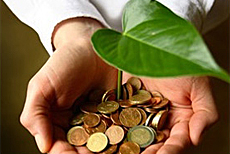To face such a theme, in an economy class in an architecture school, I don’t feel suitable enough both as a student of the latter one, and even if I had deep bases of economic knowledge; it’s hard and annoying speaking as a single person in a moment like this, and it is likewise spending words instead than actions about our continuous, but distant and conflicting, with the sustainability. Unfortunately the sustainability is a recent problem, or at least is very recent the frequency with which we use this word, and it is approached as a branch of various disciplines; but the true is that talking about it I find hard making an architectural, scientific, or whatever speech, because I see the investigation of causes and consequences of it as something totally philosophical. I see philosophy on it because is from the human kind, in the human thinking resides the virus of an illness, of which the sustainability is the therapy, and which seems to be just contained and controlled, but hardly stopped or healed; and even if we want to speak as architects, economists, biologists, we know that behind all these figures reside, first of all, human thoughts and behaviors. The growth we are proud of, the extreme development in which our present is plunged, and the deep unsustainability in which these conditions coexist, can be analyzed and shared in different disciplines, in different periods, divided in positive and negative meanings, where the formers are always more, but what is just clear, uniquely sure, is that everything we call present is nothing more than what we have been building and how we have been expressing ourselves and our nature with our wellbeing as the main and only goal to follow.
Category Archives: Economics of Sustainability
The 21st century is asked for a necessary rethink of how the design process is affecting the human habitat. Architecture, in its multifaceted concern and as discipline, has to reconsider the urban environment through its infrastructures, landscapes and buildings, and their many interdependencies within the context of natural and social ecologies. Buildings, infrastructures and the landscapes are not separated entities connected through fleble filaments, rather complex patterns composing the tridimensional, endless and dispersive urban environment where energy sources, materials, water and land are all consumed in the purpose of its developement and operation. While in the contoured and small social organism the direct information exchange was able to transform rapidly the need in the architectural and social-recognized object, in the contemporary urban environment the society doesn’t play a central role in the shaping process. Skyscrapers, well-done or not buildings rise indipendently without any effort in integration and common recognition, asserting their autonomy but affecting invisibly and deeply the pre-established connections. The design has to be a partecipated and systematic process calling urban users to push towards their needs in order to make the building an occasion to fill the gaps in the fragmentary network and discover again the humanistic value Architecture shares with Economy as much as the two disciplines use to learn and propose starting from the human behaviour preferences.
The financial project implyes profitability in the shortest term. The urban environment for the most of developers represents the perfect marketplace for the financial investment. Short time, money and competitive unsensitive minds, craving for richness, lead the urban growth towards disconnected configurations and unsustainable scenarios. Politics should be the protagonist in the urban formation, but more than often it becomes a serie of costraints that limits the private mindset. Politics should regulate the urban developement and call people directly interested in the trasformation for partecipating in the decisional process. As architects and as Yona Friedman would say, we should be less architects and more interpreters, trying to read and canalize users needs into collective formal proposals. We should consider the humanity as the only self-designer and us as technical advisors, availing ourself of several experts driving the Architecture to the final aim of sustainability.
place[less]ness
Instead of looking through impositions of the mainstream towards the discipline of architecture, today, it is essential to approach environmental problems in an alternative way including critical evaluations. The transition in development and transformation of environmental concepts in architecture and design disguises social and political shifts. Therefore it is not surprising that sustainability covering environmental, social and economic aspects, is defined in reference to development. The thought that the concept of sustainability shall reverse all of the current practices suggesting a brand new paradigm is out of basis. Read More
Architecture+Sustainability+Economics
Image Source: http://www2.uregina.ca/yourblog/environmental-economics-reducing-degradation-through-incentives/
Architecture & Happiness
image source :http://www.bluegumservices.com.au/environmental.aspx
It is very tempting to seduce ourselves, as architects or as anybody keen on architecture or otherwise involved in the design process that the answer to our problems lies with buildings. Do you actually believe you can separate buildings out from the infrastructure of cities and mobility of transit and the expectations and incentives of people?
I disagree with the point that we can separate the buildings out of the infrastructure of cities and the mobility of transit .There is a pre conceived notion of architects as designers of forms and functions for a building according to the conventional thinking .Instead architects need to become designers of eco systems, and raise questions like how Architects can improve the way of life for people. The ecological and economy systems should not only think about the people but also the natural resources like energy, water etc. The main task of architects is to incorporate the basic human consumption of these resources into our natural environment. There is a need for a solution for future development which doesn’t restrict us to the current lifestyle but improve it in a better way. Sustainability is not just a Technical problem and to make it successful it has to be addressing the Economic context. A sustainable project should improve way of life and make sense economically.
Why do people tend to believe that what is financially profitable (for developers) is not actually equivalent to economically feasible (positive impacts on social welfare)? How would you show that this does not necessarily have to be like this (but rather the opposite)?
Developers are only interested in what is financially profitable for them and think only about short term. The architect doesn’t typically choose a site for the developers; he is given the site and told to design accordingly. The architect has to be part of the larger picture to think about the sustainability of the project. To make it financially liable for developers the architect need to search for strong reasons for the developer to invest in a sustainable project. There is a need for education about the necessity and benefits of sustainable designs to expand the green buildings strategies. The architect needs to get involved in the public discussion so developers make smart decisions.
UDERSTANDING THE ECONOMIC VIABILTY IS THE KEY TO ENVIRONMENTAL SUSTAINABILTY



